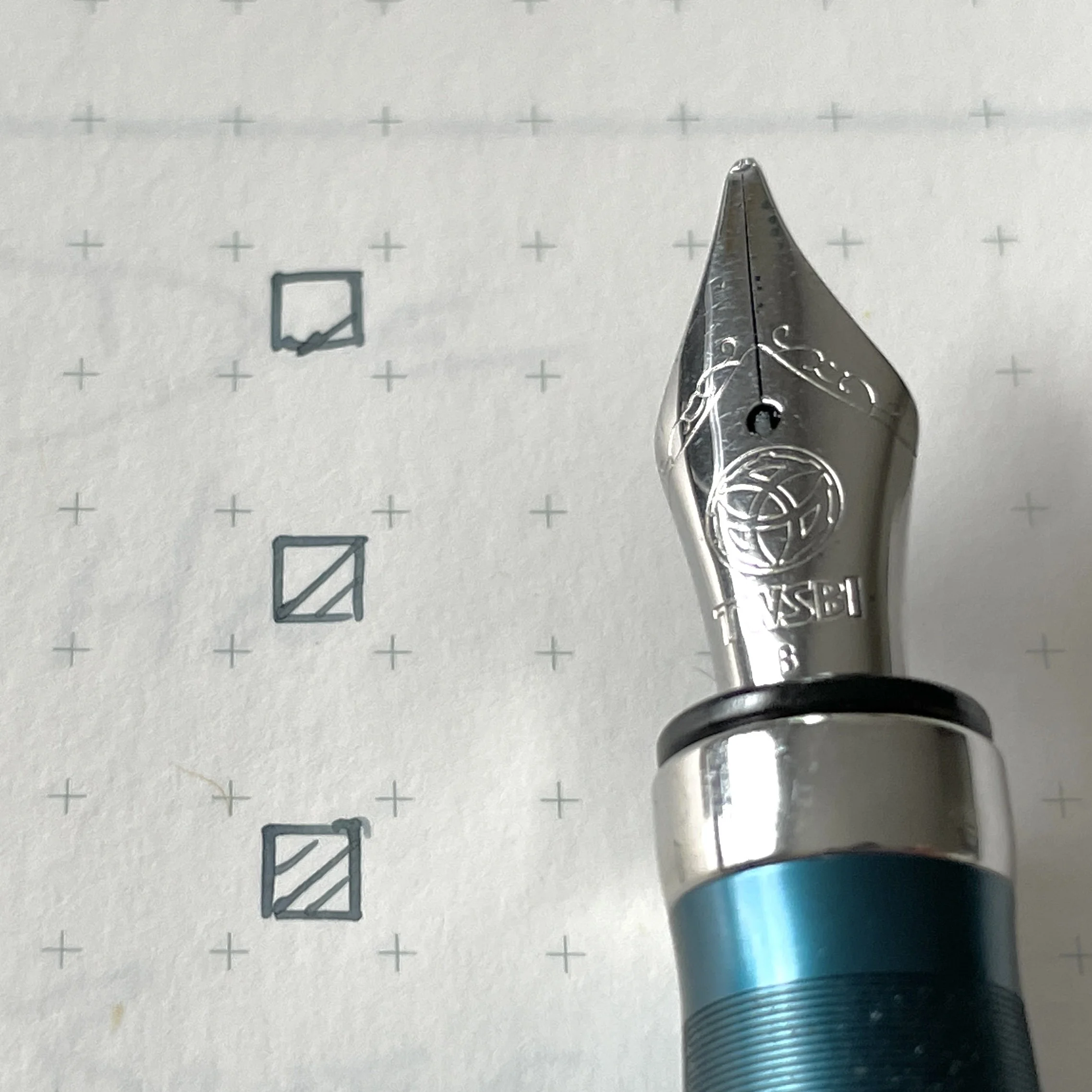The three line progress tracker
My favorite and most useful organizational systems are simple. The simpler the better. Staying organized is a means, not a destination. My pathway out of the woods.
The heart of my organizational system tracks three kinds of information. What needs to be done. When each needs to be done. And how far along each task is. And I do it all with three lines.
Well, three lines in a box.
The majority of page space in my weeklies is devoted to task lists — one per day. I devote the leftmost column of each list to checkboxes. One checkbox per task. My personal adaptation of Ryder Carroll’s Bullet Journal.
These boxes — more specifically, the lines I put in these boxes — comprise my progress tracker system. Three lines is all I need to stay on top of what needs doing.
One line, two lines, three lines
The bottom diagonal line denotes that I’ve started working on a task. Most of my tasks live with this first line. I’ve started but have yet to complete the job.
A second line splits the box midway, into two triangles. This second line tells me a task is mostly or nearly complete.
I often use this second line to note that I’m waiting on someone else’s input or collaboration. I’ve done what I can at this point.
A third diagonal line along the top of a checkbox tells me that I’ve completed the task. It’s done. Finished. Off my desk. Wahoo and celebrations.
The simple three line system provides a lot of information without demanding time from me. Box statuses make my task lists easily skimmable — so I can quickly find new tasks to work on. And it’s minimalistically eye-catching. We all deserve a little pretty now and again.
In-progress progress
Thanks to Shrutarshi for suggesting I share details on how my work bullet journal system is built. Great idea! More details to come.
This week’s Inked Tines update includes my most recent currently inked writing tools.
Toolset
Pens. The TWSBI 580-ALR, inked as it is with Troublemaker’s Petrichor is sticking around. Petrichor dries to a muted light grey in the narrow EF line. Holds up well to highlighter. Fun undertones and multi-colored shading in M lines. The multitasker nib grind makes this combo. A daily driver with personality. Became my pocket carry due to the secure TWSBI clip. Wins. 2/5.
Monteverde Giant Sequoia (EF) — 1/2. The brightest hue in my week’s palette. 441 was easily viewable on the page — excellent for accenting. The disciplined EF wrote smoothly, even on students’ copy paper. Another win. Marking, reading notes, manuscript editing, and journaling.
Franklin-Christoph 03 (EF) — 2/3. Matchy-matchy pairing. I dig an EF line that offers feedback. A solid meeting pen. Quick to uncap, round EF nib, and fun color. Success all around. Meeting notes, discussion notes, margin notes, and journaling.
Esterbrook J (EF Flex) — Empty. A surprisingly excellent pairing. The flex gave me control over Yozakura’s haloing and shading. I kept reaching for this combo when accent notes were called for. Worth revisiting in the near-future. Reading notes, manuscript marking, lesson plans, and journaling.
Franklin-Christoph 45 (B SIG) — 1/5. Fun writer for slower, thoughtful writing sessions. A handful of teaching reflections, a lesson plan outline, a partial journal entry, and reading notes. Yuletide grew on me as the week progressed.
Nakaya Neostandard (B) — 1/5. My go-to journaling pair throughout the week. The round B nib keeps me writing comfortably, even when my mind wanders and I rotate the pen in hand. Prefer to use while sitting at a desk. Journaling. Some reading notes. But mostly journaling — when writing was close to heart.
Loft Pens Highworth (EF) — 1/5. This pen sat on my desk, near to-hand, all week. At work, this pen was a scratch notes taker, a meeting notes driver, and a teaching reflecter. At home, this pair drove my notes and brainstorming for my pen group’s next meetup — and D&D plans.
Visconti Homo Sapiens (F CI) — ?? I only reached for this pair twice. Once for a lesson plan and again for part of a journal entry. Writes well, if wetly. Where’s the love gone?
Notebooks. Work bujo. Musubi Cosmo Air Light 83 (A5). Ten new pages of scribbles, thinking, and planning exist in my work planner. Next week’s weekly starts on page 182. Progress made.
Three pages of lesson plans follow the standard two-page weekly. I tapped the Esterbrook, Visconti, and Franklin-Christoph 45 for lesson planning duties. An EF, F and B. Variety is the spice of life.
The remaining pages comprise meeting notes, notes on a documentary I’m showing in my LGBTQ Studies elective, and two pages of lists in preparation for my research students’ presentations. All detailed. EF nibs were a strong choice for the week.
Green notes on Harvey Milk
Journal. YT Bindery Yu-yo (A5). Last week was a banner. 21 new pages across six separate entries. I’ve reached halfway through the second signature of this notebook. 30% completed. My partner sure picked a fun, artisanal notebook.
The writing is a potpourri of brief notes, ink research, and longform reflections. There’s joy to be had in allowing myself short, messy entries.
The first two entries are the messiest. These pages house research and brainstorming into a replacement turquoise accent ink to replace Caribbean Blue. My replacement bottle skunked last weekend. A new direction is in order.
Sailor Ink Studio 441, Lamy Pacific Blue (Turquoise?), and Diamine Asa Blue are the standouts for me. Retina searing blues with prominent shading and subtle sheen.
441 with the 411 on accenting notes
The remaining pages are a blend of short and long reflections. I chose complimentary pairings of inks. And the Nakaya twice.
Written dry. Seven of eight pens survived the week. Expected. Having eight inked pens allows me to spread the writing wealth widely across all seven non-task manager pen and ink combos. Spreading the love.
The Esterbrook did finally give up the ghost. Dry, light and scratchy as of Saturday morning. I wrote a lot with this little, aged pairing. Brought fun to my accent notes, marginalia and journaling reflections.
In the twilight of nice
Newly inked. I simply had to ink my two new arrivals. The thought occurred that I should wait until the weekend. Ensure that I commit to my eight pen plan. But joy is to be had where ink lives on fingers.
The substantial ebonite ASA is filled with Birmingham’s Andy Warhol Pop Art Purple. I steered toward a bright and present accent purple as the Esterbrook J ran dry.
And the pearlescent Kaweco Sport called out for a fancy, nuanced ink. Complexity to match, rather than hue. Robert Oster Barossa Gilt seemed fitting. An ink sample that I’ve been eager to use for over a year. The timing was finally right.
That Barossa Gilt is ready to hit the clubs
Details on the pens are just below.
The collection
Incoming / new orders. Polar opposites joined my collection this week. The largest pen I now own and one of my smallest. Size, it seems, isn’t everything.
ASA Brahmaputra in matte black ebonite. My first ebonite pen and my first ASA. Purchased gently used from a swell Slacker.
I installed a Kaigelu M Architect nib. The nib has flames on it. Because my 10-year-old self knows putting flames on a nib makes the pen write faster. It’s physics.
Definitely pretty
And a brand new Kaweco Skyline Sport in Iridescent Pearl (B) became mine. I requested a B nib for novelty. I have yet to write with a Kaweco Broad.
I even added a black clip — for style. Between the pre-ground flames nib and black clip, it’s fountain pen fashion week around here.
Ooh-la-la
Outgoing / trades or sales. No movement here. I still have three pens out on loan — each marked in my pen database.
Currently reading and listening
Fiction. I finished Mattimeo on Saturday morning. A slave ring busted. An enslaved population brought into the fold. A young person grew into his role as protector of Redwall. And a loyal friend across two books is now gone. A surprisingly engaging time.
I read my fiction electronically on my iPhone and iPad. Using a phone or tablet allows me to carry a smaller bag to and from work, libraries and coffee shops. And Apple’s cloud services allows bookmarks and highlights to sync across devices. Convenient and lightweight.
I read fiction to turn off; to break from thinking analytically. Margin notes are rare. There are few margin notes to miss when reading to unwind.
Nonfiction. I followed a thoughtful symposium on Richard Hasen’s newest book, Cheap Speech, over at the Balkinization blog this week. Charting the tendrils of disinformation tactics in modern political life.
Six excellent scholars reflect on and review the book. At the end, the author responds with a short post of their own. I’ve added Hasen’s book to my to-read list.
Music. Sleepy Fish’s 2020 albums have played on heavy rotation throughout the week. Lo-fi music done to my preference. Guitar heavy. Melody forward. With percussion that lives outside of a loop.
Plus, they’ve leaned into the storytelling possibilities that YouTube offers. Behold: a story of the sleepy fish.
Everything fades to blue this week — from swatches to Sleepy Fish.












